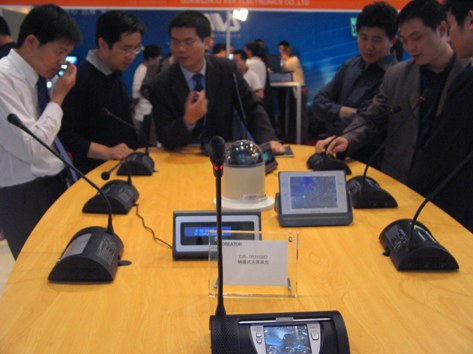 |
Large Medium Small |
|
 A videoconferencing exhibition is held recently in Beijing. Nan Shan / For China Daily
|
BEIJING - The global economic crisis has pushed companies to think of different ways to cut costs and improve efficiency. Among them, videoconferencing is becoming an option for many companies.
Videoconferencing, which refers to a set of interactive telecommunication technologies enabling two or more locations to interact with one another through video and audio, appears to be growing in popularity in China.
"China is growing at an accelerating rate ahead of the rest of the world," said Andrew Miller, chief executive officer of US-based Polycom Inc, one of the largest videoconferencing company's globally.
He added that China, the second-largest market for Polycom following the US, is expected to contribute more to Polycom's overall revenues in the next few years from the currently 10 percent.
Despite the economic slowdown, the videoconferencing market in China increased by 7 percent to 3.83 billion yuan in 2009, and is expected to reach 4.41 billion yuan this year, according to the domestic research firm CCW Research.
Spurring on the growth is government sectors adopting the technology as a way to introduce cost savings in the handling of official affairs. Government purchases made up about one third of all videoconferencing purchases in the market last year.
Large corporate users - those that didn't slash their IT budgets during the slowdown - were another driving force in the market and a focus of vendors.
"We are trying to boost our market share by going deeper into the government sector and large corporate users, especially those in the telecommunications, electricity, energy and financial fields," Huawei Technologies Co Ltd, a telecom equipment maker, said in an e-mail to China Daily.
Huawei plans to launch a series of exhibitions this year to promote its high-definition videoconferencing products, which include multiple microphones, speakers, high-definition monitors and cameras, part of its efforts to increase its videoconferencing revenue to $200 million this year from $115 million in 2009.
Huawei controlled 6.8 percent of the videoconferencing market in China last year, according to CCW Research, followed by Polycom with 35.4 percent, Suzhou Keda Technology Co Ltd with 10.2 percent, and ZTE Corporation with 8 percent.
Though governments and corporate users remain the major revenue generators, small and medium-sized enterprises (SMEs) are a growing market segment as well.
"SMEs and individual users are important parts of the overseas videoconferencing market, while in China, they are just starting to use the technology," said Ji Chendong, an analyst with research firm Frost & Sullivan.
Videoconferencing equipment can be pricey, putting the technology out of reach of some SMEs. But as more and more companies provide less expensive software-based videoconferencing services, SMEs are seeing new options to get on board.
Some companies, for example Polycom, provide services that cater to the small and medium-sized company market.
China Daily